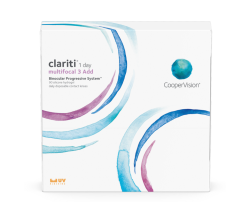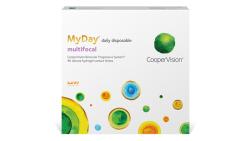
Multifocal contact lenses are designed to allow different lens powers that target vision at varying distances from the wearer. But how does this work, and does it make sense for your eyesight? We’ll help you explore multifocal contacts and how to think about whether they’re right for you.
What are multifocal contact lenses?
Multifocal contact lenses are contact lenses with multiple prescriptions all in one lens. There is typically a prescription for very close objects: one prescription for normal objects viewed at a distance, and then prescriptions for intermediate distances. This setup helps people with presbyopia correct age-related vision problems where the eye can no longer focus on objects up close.
What’s the difference between multifocals and bifocals?
Multifocal contact lenses are designed with a gradual transition between a prescription for close reading on one end and a prescription for normal distance viewing on the other. They are very similar to progressive eyeglasses. Bifocals, on the other hand, have a sharp edge between the near and far vision prescription areas of the lens.
Types of multifocal contacts
Multifocal contact lenses come in both soft lens and rigid gas permeable (RGP, or hard) lens materials.
There are two main types of multifocal contact lens designs. The most common is a set of concentric circles of lens powers prescribed for various viewing distances. There are also blended designs, which keep both the near and distance prescriptions close to the center of your eye, and mimic a natural viewing experience by correcting the specific points of aberration in your eyes.
Choosing multifocal contact lenses
How do you know if multifocal contacts make sense for you? Here are some pros and cons to weigh before and during your visit to your eye doctor.
Advantages to multifocals
Multifocals offer a range of benefits, among them:
- Better visual acuity for the range of distances from near to far.
- A less abrupt switch between prescriptions.
- The ability to see in most conditions without extra eyewear.
Drawbacks to multifocals
Multifocal contact lenses offer a lot of performance ability, but may also be:
- More difficult to adjust to due to a different viewing experience.
- Accompanied by nighttime glare and hazy or shadowy vision during the adjustment period.
- More expensive because of the increased complexity in design.
Multifocal contact lens alternatives
If multifocals don’t sound like they’re a good fit, there are a number of other options, including:
- Pairing reading glasses with normal contact lenses
- Monovision contact lenses
- Bifocal contact lenses
- Surgical correction or lens implantation recommended by your doctor
Your eye doctor is your best ally when you’re thinking about getting contact lenses and other eye care decisions. He or she will help you find the right corrective options for you to suit your lifestyle, and evaluate you in the first few months to make sure the choice was appropriate.









